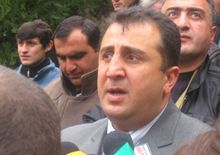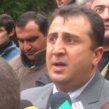
SOUTH OSSETIAN LEADER CHOOSES EUROPE
Publication: Eurasia Daily Monitor Volume: 4 Issue: 125
By:

Dmitry Sanakoyev, leader of the Tbilisi-backed provisional administrative unit in South Ossetia, visited Brussels on June 24-26 for informal introductory talks with representatives of European institutions, diplomatic missions, and think tanks and a speech in the European Parliament. Invited to Brussels by the European Union-Georgia Parliamentary Cooperation Committee, Sanakoyev conveyed a message that his administration and a large part of the local people wish to follow Georgia’s European orientation and seek EU backing for South Ossetian autonomy within Georgia.
“Georgia is returning to Europe. My region, South Ossetia, must follow the European path together with Georgia,” is how Sanakoyev summed up his approach to conflict settlement and the future of South Ossetia.
Speaking in Ossetian to the European Parliament deputies, he expressed a “profound conviction that Europe is the key to resolutions of conflicts in Georgia” — in effect, a full reversal of the long-standing misconception that “the key is in Moscow.” Sanakoyev called for looking at European models of autonomy for a negotiated agreement on South Ossetia’s autonomy within Georgia. He mentioned the autonomy of the region of South Tyrol (Alto Adige) in Italy as one of possible models.
In Sanakoyev’s vision, autonomy should guarantee the preservation of Ossetian linguistic and cultural identity, European standards of human rights observance, and targeted investment in economic recovery programs in South Ossetia. As an early measure in that regard, Sanakoyev called for EU support to the Georgian government’s program of compensation and property restitution to victims of the 1990-92 conflict. (Most Ossetians eligible to benefit from the program are from villages deep inside Georgia, outside the autonomy’s boundaries; but the political effect of the compensation/restitution program would strongly resonate in South Ossetia proper.)
According to Sanakoyev, the appeal of Europe can be a decisive factor in promoting confidence building between Ossetians and the rest of Georgia during the post-conflict period. By the same token, the EU is in a position to shape the political settlement through economic rehabilitation projects in the territory. Ultimately, the EU is best placed to mediate the political dialogue between Tbilisi and both sets of local authorities in South Ossetia, he noted. Sanakoyev outlined a two-stage program in which the conflict’s resolution would be followed by political consolidation of the autonomy within the reunited state.
In his remarks in Brussels, Sanakoyev deplored Moscow’s policy to “poison relations” and incite ethnic strife between Ossetians and Georgians for geopolitical goals, using the Kokoiti-led authorities to block a political settlement. He called for hands-on European participation in resolution efforts to overcome the Soviet-legacy, past-oriented manipulation of the conflict. Sanakoyev’s visit marked the first major step to inform Brussels about the situation on the ground directly from a political representative of the local population, rather than from Russian diplomats claiming to speak for South Ossetia.
As a matter of policy Tbilisi seeks open dialogues both with Sanakoyev’s provisional administrative unit based in Kurta and with the Russian-installed authorities under Eduard Kokoiti in Tskhinvali. However, Kokoiti’s group mainly represents Russian interests rather than local ones in the negotiations. Georgia proposes that the Sanakoyev’s alternative leadership be included in the existing negotiating formats in the context of broadening these. In the meantime, Tbilisi and the Kurta administration are reaching beyond those narrow formats, directly to relevant European structures. Such outreach could lead gradually to de facto acceptance of Sanakoyev’s administration as authentically representative of local South Ossetian interests, contrasting with the Moscow-appointed Tskhinvali group.
The Georgian-backed Alania TV channel, which is beamed to South Ossetia, broadcast Sanakoyev’s speech in the European parliament and other footage of his Brussels visit in several programs on June 26. On that day, Tskhinvali authorities declared an electricity breakdown in an apparent attempt to suppress the broadcasts.
Sanakoyev, a former “defense minister” and “prime minister” of the secessionist authorities, leads a group that broke with the Russian-installed authorities in 2005-2006, when Georgia’s successful development began exercising a gravitational attraction to many Ossetians. Prominent members of the Sanakoyev administration share his background in the former secessionist movement. One of this group, Alan Parastayev, is currently detained in Tskhinvali in preparation for a likely show trial.
The emergence of Sanakoyev’s group reflects an incipient sea change at the level of mentalities among local Ossetians, and almost certainly will accelerate that process. It is an change from default russification (which is almost total in North Ossetia) to a recovery of ethnic identity; from provincial isolation to the emergence of an interest in Europe; and from a Russia-centered political outlook to growing confidence in the Georgian state — all of this a consequence of Georgia’s successful national development in the last few years.
(Messenger, Rustavi-2 and Imedi televisions, South Ossetian Press and Information Center, June 24-27)




